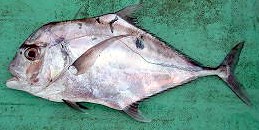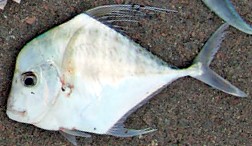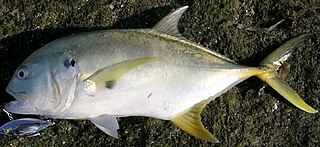Horse mackerel is a vague vernacular term for a range of species of fish throughout the English-speaking world. It is commonly applied to pelagic fishes, especially of the Carangidae family, most commonly those of the genera Trachurus or Caranx. Species known as "horse mackerel" in one English dialect or another include:

The Carangidae are a family of ray-finned fish that includes the jacks, pompanos, jack mackerels, runners, trevallies, and scads. It is the largest of the six families included within the order Carangiformes. Some authorities classify it as the only family within that order but molecular and anatomical studies indicate that there is a close relationship between this family and the five former Perciform families which make up the Carangiformes.

The Atlantic horse mackerel, also known as the European horse mackerel or common scad, is a species of jack mackerel in the family Carangidae, which includes the jacks, pompanos and trevallies. It is found in the eastern Atlantic Ocean off Europe and Africa and into the south-eastern Indian Ocean. It is an important species in commercial fisheries and is listed as a Vulnerable species on The IUCN Red List of Threatened Species.

The crevalle jack, also known as the common jack, black-tailed trevally, couvalli jack, black cavalli, jack crevale, or yellow cavalli is a common species of large marine fish classified within the jack family, Carangidae. The crevalle jack is distributed across the tropical and temperate waters of the Atlantic Ocean, ranging from Nova Scotia, Canada to Uruguay in the western Atlantic and Portugal to Angola in the eastern Atlantic, including the Mediterranean Sea. It is distinguishable from similar species by its deep body, fin colouration and a host of more detailed anatomical features, including fin ray and lateral line scale counts. It is one of the largest fish in the genus Caranx, growing to a maximum known length of 124 cm and a weight of 32 kg, although is rare at lengths greater than 60 cm. The crevalle jack inhabits both inshore and offshore waters to depths of around 350 m, predominantly over reefs, bays, lagoons and occasionally estuaries. Young fish dispersed north by currents in the eastern Atlantic are known to migrate back to more tropical waters before the onset of winter; however, if the fish fail to migrate, mass mortalities occur as the temperature falls below the species' tolerance.

The African pompano, also known as the pennant-fish or threadfin trevally, is a widely distributed species of tropical marine fish in the jack family, Carangidae. The species is found in tropical waters worldwide, with adults often inhabiting coastlines, while juveniles are usually pelagic, floating with ocean currents. The adult African pompano is similar in appearance to the other members of the genus Alectis, with the concave shape of the head near the eyes; the clearest distinguishing feature. The juveniles are similar to other members of Alectis, having long, filamentous dorsal and anal fin tips which are thought to discourage predators. The species lives in depths less than 100 m, consuming a range of crustaceans and small fishes. The species is of minor economic importance, often taken amongst other tropical midwater fishes by hook and line, while juveniles are occasionally caught in beach seines. African pompano are also highly rated game fish, often considered one of the strongest of the jacks in larger sizes.

The Indian threadfish, also known as the Indian threadfin, diamond trevally, mirror fish or plumed trevally, is a large species of coastal marine fish of the jack family, Carangidae. The species is widespread in the waters of the tropical Indo-West Pacific Ocean, ranging from east Africa to India, Asia, Indonesia and Australia. Adult fish tend to inhabit coastal waters over reefs down to 100 m in depth, while juveniles inhabit a variety of environments including estuaries and seagrass beds. The Indian threadfish is similar to the other two species in the genus Alectis, with a slight concavity in the profile of the head the most obvious distinguishing feature. It is a large species, growing to 165 cm and 25 kg in weight. The species is carnivorous, consuming fishes, cephalopods and crustaceans. The Indian threadfish is of minor commercial importance, and has been the subject of aquaculture in Singapore.

The African threadfish, also known as the Alexandria pompano, is a species of large marine fish in the jack family, Carangidae. The species is distributed along the coast of tropical Africa in the eastern Atlantic Ocean, extending to the Mediterranean Sea. Adults live predominantly in waters shallower than 70 m deep, often forming small schools. The African threadfish is similar in appearance to the closely related and co-occurring African pompano, with the species' most definitive feature its slightly concave head profile. Like other members of the genus Alectis, the juveniles of the species have long trailing dorsal and anal fins. The African threadfish is of minor commercial importance, and is also considered to be a game fish.

The horse-eye jack, also known as the big-eye jack, is a game fish and minor commercial fish in the family Carangidae. Its appearance is similar to that of the crevalle jack, although the horse-eye jack's head is not as blunt. The horse-eye jack is known to feed on smaller fish and on many invertebrates, such as shrimp and crab.

The longfin trevally, also known as the longfin kingfish, longfin cavalla or armed trevally, is a species of inshore marine fish in the jack family, Carangidae. The species is common in tropical to subtropical waters of the Indo-Pacific, ranging from South Africa in the west to Japan in the east, typically inhabiting inshore reefs and bays. The species is easily distinguished by its elongate dorsal and anal fin lobes and filamentous dorsal rays, as well as its scaleless breast. Longfin trevally are pelagic predators, taking a variety of small fish, cephalopods and crustaceans, and reach sexual maturity at around 21 cm. The species has a maximum known length of 57 cm and weight of 3.5 kg. The longfin trevally has a very complex taxonomic history which is closely intertwined with another currently valid species, Carangoides ciliarius, which may yet prove to be synonymous. Longfin trevally are of minor importance to fisheries throughout their range and are considered good table fish, and are occasionally taken by anglers.
Carangoides ciliarius is a dubious species of marine fish in the jack and horse mackerel family, Carangidae. The validity of the species has been questioned by a number of authors, with many concluding it is a synonym of the similar Carangoides armatus, commonly known as the longfin trevally. However, this synonymy has not been accepted by all authorities, with Fishbase and ITIS both recognising it as a valid species. Like Carangoides armatus, the species is occasionally referred to as the 'longfin kingfish'.

The Pacific crevalle jack is a species of large marine fish classified in the jack family Carangidae. The species is distributed through the tropical waters of the eastern Pacific Ocean from California in the north to Peru in the south, including several offshore islands. The species is best identified by its deep body and mostly unscaled breast, as well as other more detailed anatomical features. The species is known to grow to a maximum length of 101 cm and a weight of 19.7 kg. Disagreement on the status of the species has been significant in the scientific literature, with many claiming it to be conspecific with or subspecific to the Atlantic Caranx hippos. The most recent review of the crevalle jacks strongly concluded it to be a separate species based on the development of hyperostosis and fin colouring. It is predominantly a schooling inshore species, inhabiting sandy and rocky substrates, although larger individuals are occasionally found living pelagically to depths of 350 m. The Pacific crevalle jack is a fast-swimming predator, taking a variety of fish, crustaceans, and other small invertebrates. Spawning is thought to occur year-round, although peaks occur during November and May. The Pacific crevalle jack is an important species to commercial fisheries, with data available from Colima in Mexico indicating it accounts for up to 15% of the entire yearly catch. Pacific crevalle jack are highly rated gamefish, taken by both bait and a variety of lures, but are considered relatively poor quality food.

The longfin crevalle jack is a recently described species of large marine fish classified in the jack family, Carangidae. It inhabits the subtropical waters of the east Atlantic Ocean, ranging along the African coast from Mauritania south at least to Moçamedes in southern Angola, with the species historically present in the Mediterranean Sea. It is an inshore species, known to occasionally penetrate estuaries, possibly to spawn. The species is very similar to the crevalle jack, Caranx hippos, and is separated by its extended dorsal and anal fin lobes as well as more detailed anatomical features including dorsal and anal fin ray counts. The fish is known to reach 127 cm in length and 20.9 kg in weight. The longfin crevalle jack is a predatory fish, taking small fish as its main prey. Due to longstanding confusion between C. fischeri and C. hippos, the importance of each species to African fisheries is poorly understood, with a known combined catch in this region of between 2,233 and 10,054 tonnes per year in 1995–2004. Like its close relatives, the species is considered a powerful gamefish and highly sought after, although their coarse flesh makes for relatively poor quality food.

The yellowstripe scad, also known as the yellowstripe trevally, yellow-banded trevally, smooth-tailed trevally, slender-scaled trevally and slender trevally, is a species of small inshore fish in the jack and horse mackerel family Carangidae, and the only member of the genus Selaroides. The yellowstripe trevally is distributed throughout the tropical waters of the Indo-West Pacific region, ranging from the Persian Gulf in the west to Vanuatu and New Caledonia in the east. The species is distinguished by its prominent lateral yellow band, and differs from the scads of the genus Selar in having a smaller eye and different dentition. Although the yellowstripe scad reaches a maximum recorded length of 22 cm, it is normally encountered at sizes less than 15 cm. Phylogenetic studies indicate the yellowstripe scad is closely related to the scads of the genus Selar, although its exact placement in the family Carangidae is less well agreed upon.

Selar is a genus of ray-finned fishes from the family Carangidae which includes the scads, jacks, pompanos, trevallies and horse mackerels. The generic name, Selar, is the local name for the oxeye scad in Jakarta.
The Crozet scad is a species of jack mackerel from the family Carangidae, the jacks, pompanos and trevallies, which is found off oceanic islands and over banks and sea mountains in the south east Atlantic and south western Indian Oceans.











